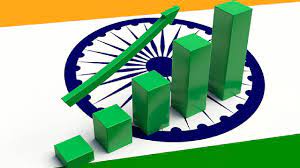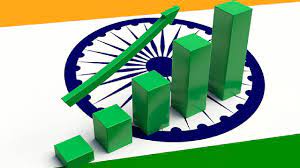
According to a latest prediction by S&P Global and Morgan Stanley, the Indian economy will surpass that of Japan and Germany within 23030 to become the third-largest economy.
The basis of S&P's projections is the assumption that the annual nominal GDP growth rate of India will be at an average of 6.3% till 2030. According to Morgan Stanley, India's GDP will increase by more than double compared ot its current levels by 2031.
“India has the conditions in place for an economic boom fueled by offshoring, investment in manufacturing, the energy transition, and the country’s advanced digital infrastructure,” Morgan Stanley analysts led by Ridham Desai and Girish Acchipalia wrote in the report.
“These drivers will make [India] the world’s third-largest economy and stock market before the end of the decade.”
India's year-on-year growth rate for the July-September quarter was 6.3%, which was slightly higher than the 6.2% predicted by Reuters poll of economists earlier. Before this latest growth sate, India experienced a 13.5% increase in April to June compared to the same period last year, boosted by strong domestic demand in the country's service sector.
According to Refinitiv data, the country experienced a record 20.1% year-on-year growth in the three months ending June 2021.
“These drivers will make [India] the world’s third-largest economy and stock market before the end of the decade.”
Morgan Stanley and S&P expect India's trade and financial liberalization, labor market reform, and investment in infrastructure and human capital to continue.
“This is a reasonable expectation from India, which has a lot to ‘catch up’ in terms of economic growth and per capita income,” Dhiraj Nim, an economist from Australia and New Zealand Banking Group Research, said.
According to Nim, some of the reforms of the government mentioned above have already begun. Zim also emphasized that the government's commitment to include more capital expenditure in the country's annual expenditure books.
According to S&P analysts, India's government is clearly focused on becoming a hub for foreign investors as well as a manufacturing powerhouse, and their primary vehicle for doing so is the Production Linked Incentive Scheme to boost manufacturing and exports.
The PLIS, which went into effect in 2020, provides incentives to both domestic and foreign investors in the form of tax breaks and license clearances, among other things.
“It is very likely that the government is banking on PLIS as a tool to make the Indian economy more export-driven and more inter-linked in global supply chains,” S&P analysts wrote.
Based on the same parameters, Morgan Stanley estimates that Indian manufacturing's share of GDP will "rise from 15.6% of GDP currently to 21% by 2031," implying that manufacturing revenue could triple from $447 billion to around $1,490 billion.
“Multinationals are more optimistic than ever about investing in India … and the government is encouraging investment by both building infrastructure and supplying land for factories,” Morgan Stanley said.
“India’s advantages [include] abundant low-cost labor, the low cost of manufacturing, openness to investment, business-friendly policies and a young demographic with a strong penchant for consumption,” said Sumedha Dasgupta, a senior analyst from the Economist Intelligence Unit.
According to her, these factors make India an appealing choice for establishing manufacturing hubs until the end of the decade.
A prolonged global recession would be a significant challenge to Morgan Stanley's forecast, as India is a highly trade-dependent economy, with nearly 20% of its output exported.
Other risk factors cited by the US investment bank include a lack of skilled labor, adverse geopolitical events, and policy errors caused by voting for a "weaker government."
According to India's finance ministry, a global slowdown may dampen India's export business outlook.
Even though India's GDP is already above pre-Covid levels, forward-looking growth will be "much weaker" than in previous quarters, according to Sonal Varma, chief economist at Nomura.
“Real GDP is now 8% above pre-Covid levels in growth rate terms ... but in terms of the forward looking view, there are headwinds from the global side financial conditions,” Varma said while also warning that there will be a cyclical slowdown ahead.
Similarly, Nim stated that human capital investment through education and health could be prioritized.
“This is especially important for a post-pandemic economy where greater disruptions to the informal sector have meant widened economic and wealth inequalities,” he said, adding that falling labor force participation rate, especially among women, was concerning.
(Source:www.businessinsider.in)
The basis of S&P's projections is the assumption that the annual nominal GDP growth rate of India will be at an average of 6.3% till 2030. According to Morgan Stanley, India's GDP will increase by more than double compared ot its current levels by 2031.
“India has the conditions in place for an economic boom fueled by offshoring, investment in manufacturing, the energy transition, and the country’s advanced digital infrastructure,” Morgan Stanley analysts led by Ridham Desai and Girish Acchipalia wrote in the report.
“These drivers will make [India] the world’s third-largest economy and stock market before the end of the decade.”
India's year-on-year growth rate for the July-September quarter was 6.3%, which was slightly higher than the 6.2% predicted by Reuters poll of economists earlier. Before this latest growth sate, India experienced a 13.5% increase in April to June compared to the same period last year, boosted by strong domestic demand in the country's service sector.
According to Refinitiv data, the country experienced a record 20.1% year-on-year growth in the three months ending June 2021.
“These drivers will make [India] the world’s third-largest economy and stock market before the end of the decade.”
Morgan Stanley and S&P expect India's trade and financial liberalization, labor market reform, and investment in infrastructure and human capital to continue.
“This is a reasonable expectation from India, which has a lot to ‘catch up’ in terms of economic growth and per capita income,” Dhiraj Nim, an economist from Australia and New Zealand Banking Group Research, said.
According to Nim, some of the reforms of the government mentioned above have already begun. Zim also emphasized that the government's commitment to include more capital expenditure in the country's annual expenditure books.
According to S&P analysts, India's government is clearly focused on becoming a hub for foreign investors as well as a manufacturing powerhouse, and their primary vehicle for doing so is the Production Linked Incentive Scheme to boost manufacturing and exports.
The PLIS, which went into effect in 2020, provides incentives to both domestic and foreign investors in the form of tax breaks and license clearances, among other things.
“It is very likely that the government is banking on PLIS as a tool to make the Indian economy more export-driven and more inter-linked in global supply chains,” S&P analysts wrote.
Based on the same parameters, Morgan Stanley estimates that Indian manufacturing's share of GDP will "rise from 15.6% of GDP currently to 21% by 2031," implying that manufacturing revenue could triple from $447 billion to around $1,490 billion.
“Multinationals are more optimistic than ever about investing in India … and the government is encouraging investment by both building infrastructure and supplying land for factories,” Morgan Stanley said.
“India’s advantages [include] abundant low-cost labor, the low cost of manufacturing, openness to investment, business-friendly policies and a young demographic with a strong penchant for consumption,” said Sumedha Dasgupta, a senior analyst from the Economist Intelligence Unit.
According to her, these factors make India an appealing choice for establishing manufacturing hubs until the end of the decade.
A prolonged global recession would be a significant challenge to Morgan Stanley's forecast, as India is a highly trade-dependent economy, with nearly 20% of its output exported.
Other risk factors cited by the US investment bank include a lack of skilled labor, adverse geopolitical events, and policy errors caused by voting for a "weaker government."
According to India's finance ministry, a global slowdown may dampen India's export business outlook.
Even though India's GDP is already above pre-Covid levels, forward-looking growth will be "much weaker" than in previous quarters, according to Sonal Varma, chief economist at Nomura.
“Real GDP is now 8% above pre-Covid levels in growth rate terms ... but in terms of the forward looking view, there are headwinds from the global side financial conditions,” Varma said while also warning that there will be a cyclical slowdown ahead.
Similarly, Nim stated that human capital investment through education and health could be prioritized.
“This is especially important for a post-pandemic economy where greater disruptions to the informal sector have meant widened economic and wealth inequalities,” he said, adding that falling labor force participation rate, especially among women, was concerning.
(Source:www.businessinsider.in)





